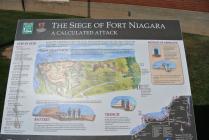Inscription
A Calculated Attack
In July 1759, 2,300 British and New York troops, with about 900 Iroquois allies laid siege to French-held Fort Niagara. 19 days later, with its wall breached and a French relief force defeated only a mile away, Fort Niagara surrendered.Plan of Attack
Laying siege to a fort required technical skill and much backbreaking labor. Beginning about 1,000 yards away, attackers dug a trench or "sap" toward the fort. The trench zigzagged its way towards the fort to deflect enemy fire. When the trench was within about 400 yards, artillery batteries were built to bombard the fort.
1. July 10: British open trenches about 1,000 yards from Fort Niagara. The French inside the fort can see fresh dirt at about 640 yards.
2. July 17: British open artillery batteries about 300-400 yards from the fort and bombard the walls with solid iron cannon balls ranging in size from 6 to 18 pounds apiece.
3. July 23: Final British battery is only 100 yards from the fort's outer works. Within two days the fort will surrender.
A siege was an orderly process bound by procedures that were perfected in Europe during the 17th and early 18th centuries. Although Fort Niagara lay deep in the wilderness of North America, the siege of 1759 closely followed siege techniques and conventions that were standard in Europe.
Trench
To safely approach the fort, attackers built trenches and earthworks reinforced by gabions (twig baskets designed to be filled with earth) and fascines (bundles of sticks used to shore up earthen walls).
Engineers first marked out the route of the trench, then gabions were placed between the trench and the enemy.
Method of Approach
Working at night, parties of soldiers advanced the trench toward the fort's outer walls.
The end result was a trench 4½ feet wide and 5½feet deep with a thick earthen wall on one side that sheltered the attackers from enemy fire.
A soldier working on his knees dug out a shallow trench, followed by others who widened and deepened the excavation.
Attackers used mortars, fired from the trenches to lob exploding iron bombs over the forts walls.
Battery
A battery was a protected place for artillery to fire upon the fort's walls. During the Fort Niagara siege, British batteries were designed to house six guns each. Batteries were constructed by filling and covering gabions with earth, then lining the outside of the emplacement with fascines. Embrasures were cut into the battery to allow cannons to fire through the wall toward the fort.
Step By Step
July 6
British land at Four Mile Creek, skirmish with French scouts.
July 8
Main British Army marches from Four Mile Creek to camp east of Fort Niagara.
July 9
Captain Walter Rutherford delivers a surrender demand, the French commander, Captain Pierre Pouchot politely refuses.
July 10
British begin to dig their trench toward fort.
July 12
American Indians withdraw from Siege.
July 17
British complete first battery, open fire on fort.
July 20
British General John Prideaux killed, Sir William Johnson assumes command.
July 22-23
French guns are repeatedly being put out of action and then remounted.
July 23
A new British battery opens only 100 yards from the fort. Word reaches the fort that a French relief party is near.
July 24
Battle of La belle Famille fought just one mile south of Fort Niagara. French relief party is defeated, sealing the fate of Fort Niagara.
July 25
Fort Niagara surrenders
Details
| HM Number | HM19Y3 |
|---|---|
| Tags | |
| Placed By | Seaway Trail, Inc |
| Marker Condition | No reports yet |
| Date Added | Thursday, September 25th, 2014 at 8:28am PDT -07:00 |
Pictures
Photo Credits: [1] BRIDGER1963
Locationbig map
| UTM (WGS84 Datum) | 17T E 657410 N 4791786 |
|---|---|
| Decimal Degrees | 43.26245000, -79.06053333 |
| Degrees and Decimal Minutes | N 43° 15.747', W 79° 3.632' |
| Degrees, Minutes and Seconds | 43° 15' 44.82" N, 79° 3' 37.92" W |
| Driving Directions | Google Maps |
| Area Code(s) | 716 |
| Closest Postal Address | At or near 601-643 Scott Ave, Youngstown NY 14174, US |
| Alternative Maps | Google Maps, MapQuest, Bing Maps, Yahoo Maps, MSR Maps, OpenCycleMap, MyTopo Maps, OpenStreetMap |
Is this marker missing? Are the coordinates wrong? Do you have additional information that you would like to share with us? If so, check in.
Nearby Markersshow on map
Show me all markers in: Youngstown, NY | Niagara County | 14174 | New York | United States of America
Maintenance Issues
- Is this marker part of a series?
- What historical period does the marker represent?
- What historical place does the marker represent?
- What type of marker is it?
- What class is the marker?
- What style is the marker?
- Does the marker have a number?
- What year was the marker erected?
- This marker could use another picture or two.
- Can this marker be seen from the road?
- Is the marker in the median?

Comments 0 comments